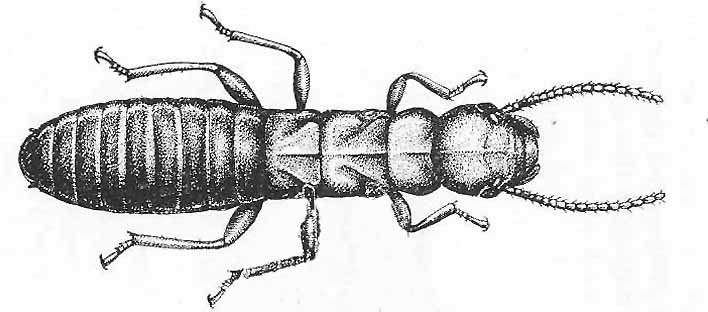
Termites (Order Isoptera)
Additional sources: Abe, Takuya, David Bignell & Masahiko Higashi, eds., 2000, Termites: Evolution, Sociality, Symbioses, Ecology, Boston: Kluwer Academic Publishers; Snyder, Thomas, 1954, Order Isoptera: The Termites of the United States and Canada, NY: National Pest Control Association; Weesner, Frances, 1965, The Termites of the United States, Elizabeth, NJ, The National Pest Control Association; La Page, Jefferey, 1974, Environmental Factors Controlling the Foraging Behavior of a Desert Subterranean Termite, Gnathamitermes Perplexus (Banks), submitted to the Department of Entomology, University of Arizona (MS Thesis); Haverty, Michael, 1974, The Significance of the Subterranean Termite, Heterotermes Aureus (Snyder), as a Detritivore in a Desert Grassland Ecosystem, submitted to the Department of Entomology, University of Arizona (Ph.D. Thesis).(Logo image above adapted from Snyder, p61.)
"Isoptera" means "equal wings", referring to the fact that the adult reproductive termites have two pairs of equal-length wings. On close inspection, this distinguishes them from the flying reproductive ants, whose forewings are larger than their hindwings, and termites also differ from ants in that they lack the "wasp waist" -- the narrow waist joining two segments of the abdomen. They also differ from ants in the shape of their antennae -- more softly curved and "beadlike" (see above), contrasting with the more "elbowed" shapes of ant antennae. They are in fact not closely related to ants, but are genetically closer to the cockroaches and the mantids. Today's wood-feeding cockroach (genus Cryptocerus -- one species is present in the Western US) is especially close to some primitive termites (genus Mastotermes). Current evolutionary evidence suggests that termites, cockroaches, and mantids differentiated out of some common ancestor in an explosive evolutionary radiation during the Mesozoic era (Abe et al, 68-9), and some entomologists group these three within the Superorder Dictyoptera ["network-wing"]. Today's order Isoptera is relatively small, approximately 2,200 species.
Like many wasps, the ants, and many bees, termites are eusocial, caring for their offspring in "colonies" (large families). They live most of their lives in dark nests and tunnels (only the flying reproductives are dark-colored), the full-grown worker denizens being mostly a creamy white, soft-bodied, and blind. They are sharply differentiated into castes of workers, soldiers, and reproductives, each physically distinctive and pursuing distinctive tasks. They differ from the Hymenoptera in having (typically) bisexual castes and no known sub-social groups.
The Isoptera are also distinct from other social insects in that they eat cellulose-rich vegetable matter (dead wood or other vascular tissues -- leaf litter, dead grasses, dung, rich soil etc.) as their principal energy source. In this regard they are similar to certan kinds of cockroaches (mentioned above -- but these roaches are sub-social insects).
Globally speaking, termite species richness is highest in lowland tropical forests, and drops very rapidly as you move above or below 10 degrees in latitude. In the United States, generic richness is greatest in our own Southwest, the drier regions being richer than the more temperate ones. "The endemic desert [termitid] fauna consists predominantly of dry vegetation feeding termitids (genera Gnathamitermes and Tenuirostritermes) forming an ecologically very important part of the fauna.” (Abe et al, p. 32)
Worldwide, entomologists recognize 7 Families of termites with more than 2,000 species, but in North America just four Families are known, with some 44 distinctive species. In relation to Biogeographical Regions, all of the continental United States lies within the "Nearctic" region, in which termite richness is generally low, the only major termite habitats being desert and arid grasslands, but our Southwest is fairly rich and Arizona has representatives of all four Families, with 19 species known:
1) Desert Termites (Family Termitidae)
The Termitidae are called the "Higher Termites", distinguished by having bacteria in their guts (rather than protozoa).The largest of all Termite Families (with about 85% of all known genera), the Termitidae are represented by just two groups in our area: the genus Gnathamitermes and the genus Tenuirostritermes, and a total of 8 species. Both of these groups are dry vegetation feeders, and perform an ecologically very important role in the Sonoran Desert.
Gnathamitermes species:
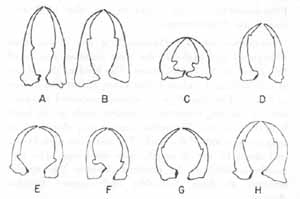 are identified in the image at left (adapted from Weesner, Fig.19). (Click on the image to enlarge it.) These are Mandibles of the soldiers of each species of Termitidae found in our region; A & B are the mandibles of the two Gnathamitermes species.
are identified in the image at left (adapted from Weesner, Fig.19). (Click on the image to enlarge it.) These are Mandibles of the soldiers of each species of Termitidae found in our region; A & B are the mandibles of the two Gnathamitermes species.
Both species are primarily subterranean (and seldom seen), yet build extensive above-ground earthen workings to cover the wooden structures they consume -- weathered grasses, cow-chips, etc, but only the weathered portions of solid wood objects. They thus do not seriously damage human-built structures. They work largely at night, covering low vegetation and grass with thin, earth-like mud mortar, building clay tubes and mortar sheets, usually after rains. The colonies are located deep down in the ground and may be quite large. Flights of the reproductives generally occur in spring or summer during the daytime, after rainfall.
Below left: on a section of Saguaro rib lying on the ground, in October of 2003 after good rains, showing the mud covering the termites have built to protect their activities; on the right, when the covering (paper-thin) is broken open, we reveal the extent of the termite feast (now concluded, which has consumed only the weathered-white surface of the wood (click on the right-hand image for a close-up):
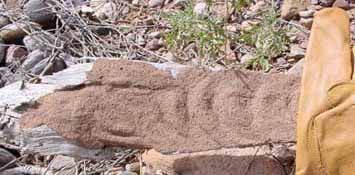 ..
..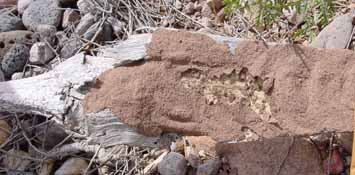
In January 2005, we were removing a pile of debris from a terrace above lower Hot Springs Canyon, and turned over some heavy pieces of thickened lumber, revealing below some extensive termite nesting and feeding on the side of the wood which was seated on the ground:
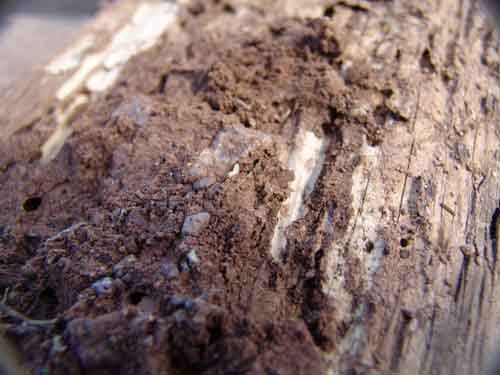
A whitish termite is visible as the wormlike form right in the center of the photograph above, a short distance left of the (also whitish) newly-consumed wood surface. Below, a somewhat closer view shows two termites, one at left in shadow right near the newly-denuded surface, and one in the mud at lower right-center:
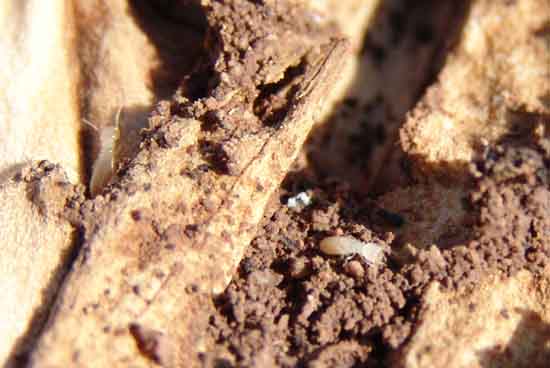
These are very small creatures, so we put them on a human hand to gain a better sense of measureable scale. Below left, apparently attempting to bite into the skin; below right, displaying the characteristic mandibles (Click on each image to enlarge it.)
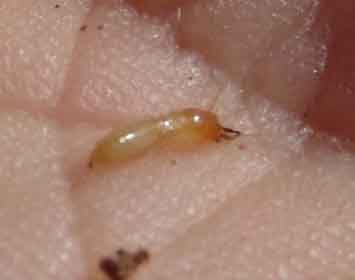 .
.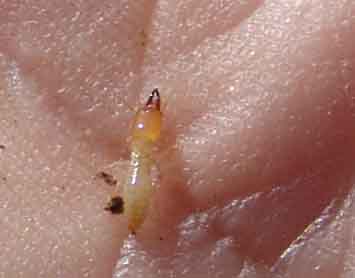
The size of this termite is roughly .8mm. The mandibles shown on the right-hand image look like the Type A or B forms shown above, belonging to the two Gnathamitermes species.
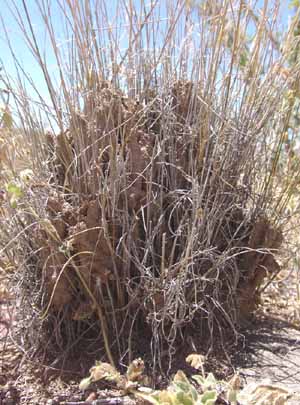 At left, the termites have built a mud mound engulfing a clump of dry grass along the Ridge Road, observed in May of 2004. (Click on the image to enlarge it.)
At left, the termites have built a mud mound engulfing a clump of dry grass along the Ridge Road, observed in May of 2004. (Click on the image to enlarge it.)
In his MS Thesis of 1974, Jeffery La Page (cited above) analyzed the behavior of Gnathamitermes perplexus on a study plot in the Santa Rita Experimental Range (a location with rainfall and vegetation patterns somewhat similar to those of Saguaro Juniper), where he built a 40 X 40 meter grid and seeded it with rolls of toilet paper in a grid at one-meter intervals. Termite foraging activity was then monitored for a one-year period, distinguishing different levels of foraging intensity in relation to variables of soil temperature and rainfall. He found that G. perplexus foraged at the rolls day and night during most of the year, but most intensively during periods which combined both measurable rainfall and "moderate to high temperatures" (9-49 degrees Centigrade) (p. 21). Changes in moisture and temperature below the soil surface were crucial variables.
La Page estimated the "maximum foraging density" of G. perplexus to be more than 700,000 foragers per hectare, suggesting that this species "is an important detritivore in the Sonoran Desert." (39) They also accomplish considerable translocation of soils, in a region where earthworms are largely absent.
2) Rotten-wood Termites (Family Hodotermitidae)
Zootermopsis laticeps are very large, damp-wood-dwelling termites, living mainly in dying cottonwood trees along streambeds. The soldiers have remarkably massive jaws. Old colonies may contain some 4,000 individuals. Their reproductive flights are nocturnal.
3) Subterranean Termites (Rhinotermitidae)
These are species which live in the soil, with no above-ground, mound-like indication of their presence, which has made them difficult to study. Michael Haverty studied Heterotermes aureus at the Santa Rita Experimental Range in 1974 in a "shrub-invaded desert grassland ecotone" where he set up circular plots, identified and measured dead wood on each, then identified foraging groups consuming the various types of wood and counted them. He then employed the toilet paper roll method of baiting described above (feasible since Heterotermes and Gnathamitermes show different patterns of roll consumption) to measure rates of consumption. Having collected several living foraging groups, he then tested their preferences for various kinds of native wood.
Haverty estimated a density of 160 foraging colonies per hectare and an average of nearly 70,000 foraging individual per hectare at any given time, with an average "foraging territory" of each colony some 13 square meters (quite small compared with other termite species). These insects were general feeders, yet appear "to prefer cholla, mesquite and catclaw over blue palo verde and other less abundant woods" (p. xiii). The intensity of foragers increased with soil moisture and temperature (to 32 degrees Centigrade). Haverty concludes that this species, along with other termites and fungi, "functions to increase fertility of the soil by the addition of available nitrogen compounds synthesized concurrently with the process of cellulose degradation [accomplished by the in-resident termite micro-organisms]. Therefore, Heterotermes aureus has been shown to be a more important component of the desert grassland ecosystem than previously imagined." (pp. 78-9)
4) Dry-wood Termites (Family Kalotermitidae)
These live in dead riparian trees, attacking dry, sound wood lying in direct contact with the ground. The reproductives fly in July, at night.
A question-mark: some termites and purple fungus
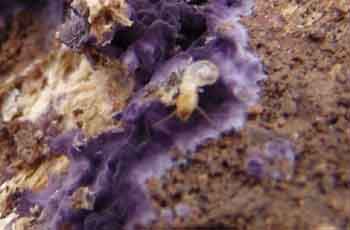
In February 2005 we encountered these termites in Hot Springs Canyon, in apparent association with the purple fungus shown above. For more details, click on this link: Purple Fungus Termites.